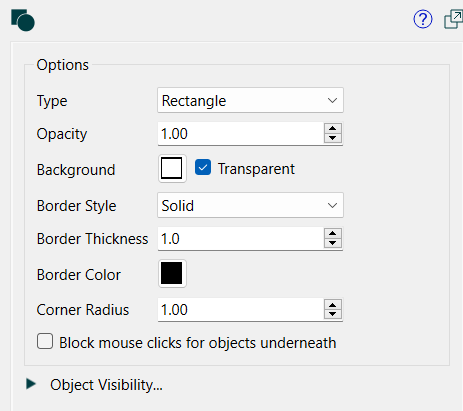The shape tool lets you place a geometric shape on the page. It is only available on the interface.
You can specify which shape to use, the outline style and color and the fill color and opacity for each shape.

Type specifies the type of shape to use:
Arrow can point up, right, down, or left and can be either Straight (
) or curved (
) with both an outline and fill (use transparent to see only the outline).
Cloudputs up a cloud image (
) with both an outline and fill (use transparent to see only the outline).
Ellipse can have both an outline and a fill. Use opacity of 0 to show only the outline. Select and resize to change the size and oval axis. When the width and height are the same an ellipse is a circle.
Horizontal Line uses only the outline. It creates a one dimensional separator between the content above and below it.
Rectangle can have both an outline and a fill. Use opacity of 0 to show only the outline. Select and resize to change the size and relative width and height. When the width and height are the same a rectangle is a square.
Speech Bubble creates a cartoon style speech bubble (
) with both an outline and fill (use transparent to see only the outline).
Star creates a star (
) with both an outline and fill (use transparent to see only the outline).
Vertical Line uses only the outline. It creates a one dimensional separator between the content to the left and right of it.
Opacity specifies how much of the outline and fill will show through. At the default of opacity of 1, the background is not visible at all. Use numbers close to 0 to make the shape almost invisible, and values between 0 and 1 to partially cover anything below the shape.
Background specifies the background color to use for the interior of the shape (ellipse and rectangle only). Click on the color button to select a color.
Border Style specifies the style used in drawing the border for a rectangle or ellipse or the entire object for one of the lines. Choose either Solid or None. If you select None, the remaining settings won't matter.
Tip: When you first place a shape it will have a solid outline.
Border Thickness lets you specify how thick, in points, you want the border around the shape (or the shape itself for the two line types) to be. This has an effect only when you've selected Solid for the Style.
Border Color lets you specify the color for the outline. Click on the displayed color button to select a color. This has an effect only when you've selected Solid for the Style.
Note Shapes will always be drawn on top of all other objects on the interface unless explicitly sent to the back (or something else is explicitly sent to the front).
Corner Radius applies to the rectangle shape, and allows you to round the corners, the default of 1 will draw right angle corners.
Block mouse clicks for objects underneath, if checked, will prevent any mouse clicks from the user reaching objects below the frame. Typically, you will need to bring the frame to the front for this action to work. If not checked, clicks will pass through even when the frame obscures objects underneath it.